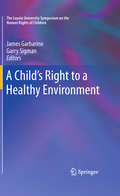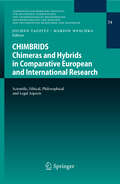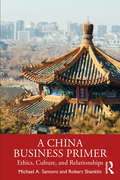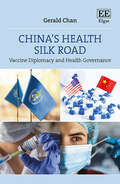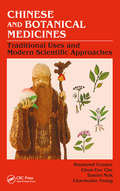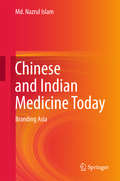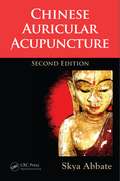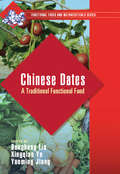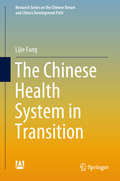- Table View
- List View
A Child's Right to a Healthy Environment (The Loyola University Symposium on the Human Rights of Children #1)
by James Garbarino Garry SigmanIt’s a startling reality that more American children are victims—and perpetrators—of violence than those of any other developed country. Yet unlike the other nations, the United States has yet to ratify the United Nations Convention on the Rights of the Child. Compelling, readable, and interdisciplinary, A Child’s Right to a Healthy Environment provides an abundance of skilled observation, important findings, and keen insights to place children’s well-being in the vanguard of human rights concerns, both in the United States and globally.Within this volume, authors examine the impediments to the crucial goals of justice, safety, dignity, well-being, and meaning in children’s lives, factors as varied as socioeconomic stressors, alienated, disengaged parents, and corrosive moral lessons from the media. The complex role of religious institutions in promoting and, in many cases, curtailing children’s rights is analyzed, as are international efforts by advocates and policymakers to address major threats to children’s development, including:War and natural disasters.Environmental toxins (e.g., malaria and lead poisoning).The child obesity epidemic.Gun violence.Child slavery and trafficking.Toxic elements in contemporary culture.A Child’s Right to a Healthy Environment is a powerful call to action for researchers and professionals in developmental, clinical child, school, and educational psychology as well as psychiatry, pediatrics, social work, general and special education, sociology, and other fields tasked with improving children’s lives.
CHIMBRIDS - Chimeras and Hybrids in Comparative European and International Research: Scientific, Ethical, Philosophical and Legal Aspects (Veröffentlichungen des Instituts für Deutsches, Europäisches und Internationales Medizinrecht, Gesundheitsrecht und Bioethik der Universitäten Heidelberg und Mannheim #34)
by Jochen Taupitz Marion WeschkaNational, European and international concepts and strategies concerning the legal and ethical framework of chimera and hybrid research are still largely missing, even though they are absolutely necessary in order to use the potential of chimera and hybrid research effectively and efficiently for the benefit of science and society. The outcome of the CHIMBRIDS-Project successfully sheds light on the chances and risks of this research and provides legal solutions to existing problems in order to help decision-makers fulfil their tasks in an informed and efficient manner. This comprehensive volume details the complete results, contributed by 40 scholars from 10 member states of the European Union, Canada, China, Israel, Japan, Switzerland and the US, with descriptive reports of the legal situation in specific countries and in-depth analysis of all scientific, medical, ethical and legal implications of chimera and hybrid research.
Chimera Research: Methods and Protocols (Methods in Molecular Biology #2005)
by Insoo Hyun Alejandro De Los AngelesThis volume addresses challenging new questions surrounding stem cell-based chimera research. This book is organized into three parts: Part One provides readers with a summary of different human donor cell types. The chapters in this section discuss ways to evaluate new types of pluripotent stem cells; the derivation of naïve and primed pluripotent stem cells from mouse preimplantation embryos; and the ethical and regulatory complexities of informed consent for the procurement of somatic cells. Part Two discusses methods for generating chimeras. The chapters here look at chick models and human-chick organizer grafts; generating human-pig interspecies chimeras; and techniques for transplanting mouse neural stem cells into a mouse disease model for stroke. Part Three concludes the book with a look at ongoing ethical controversies and new scientific directions. Chapters in this part cover the ethics of crossing the xenobarrier; animal welfare; experimentation with spermatogonial stem cells; and cautious approaches to human-monkey chimera studies to further understand complex human brain disorders. Written in the highly successful Methods in Molecular Biology series format, chapters include introductions to their respective topics, lists of the necessary materials and reagents, step-by-step, readily reproducible laboratory protocols, and tips on troubleshooting and avoiding known pitfalls.Cutting-edge and thorough, Chimera Research: Methods and Protocols is a valuable resource for scientists interesting in using chimeras as a research tool while also taking into consideration their complex ethical scopes.
Chimeric Antigen Receptor T-Cell Therapies for Cancer E-Book: A Practical Guide
by Daniel W. Lee Nirali N. ShahFrom patient referral to post-therapy management, Chimeric Antigen Receptor (CAR) T-Cell Therapies for Cancer: A Practical Guide presents a comprehensive view of CAR modified T-cells in a concise and practical format. Providing authoritative guidance on the implementation and management of CAR T-cell therapy from Drs. Daniel W. Lee and Nirali N. Shah, this clinical resource keeps you up to date on the latest developments in this rapidly evolving area.Covers all clinical aspects, including patient referral, toxicities management, comorbidities, bridging therapy, post-CAR monitoring, and multidisciplinary approaches to supportive care. Includes key topics on associated toxicities such as predictive biomarkers, infections, and multidisciplinary approaches to supportive care. Presents current knowledge on FDA approved CAR T-cell products as well as developments on the horizon. Editors and authors represent leading investigators in academia and worldwide pioneers of CAR therapy.
Chimeric Antigen Receptor T Cells: Development and Production (Methods in Molecular Biology #2086)
by Kamilla Swiech Kelen Cristina Ribeiro Malmegrim Virgínia Picanço-CastroThis volume provides comprehensive methods from expert scientists working in the Chimeric Antigen Receptor T Cell (CAR-T Cell) field. Chapters guide readers through the state-of-art of CAR-T cell technology, CAR design and vector production, CAR-T cell generation and manufacturing, CAR-T cell characterization, and quality control. Written in the highly successful Methods in Molecular Biology series format, chapters include introductions to their respective topics, lists of the necessary materials and reagents, step-by-step, readily reproducible laboratory protocols, and tips on troubleshooting and avoiding known pitfalls. Authoritative and cutting-edge, Chimeric Antigen Receptor T Cells: Development and Production aims to be useful in the production of CAR-T cells, especially for therapeutic purposes.
Chimeric RNA: Methods and Protocols (Methods in Molecular Biology #2079)
by Hui Li Justin ElfmanThis book provides numerous methods for identification, validation, and functional characterization of chimeric RNAs, herein described as any transcript which contains the nucleotide sequence of two distinct parental genes. Beginning with identification and characterization through bioinformatics tools, the book continues with experimental validation using RT-PCR, hybridization methods for RNA, and the use of mass spectrometry data for fusion protein validation, as well as functional and mechanistic studies of chimeric RNAs and translational applications. Written for the highly successful Methods in Molecular Biology series, chapters include introductions to their respective topics, lists of the necessary materials and reagents, step-by-step, readily reproducible laboratory protocols, and tips on troubleshooting and avoiding known pitfalls. Authoritative and practical, Chimeric RNA: Methods and Protocols is an ideal guide to this expansive field and an inspiration to researchers seeking to further our knowledge of these remarkable features of the transcriptome.
Chimerism: A Clinical Guide
by Nicole L. DraperThis text provides a comprehensive, up-to-date review of chimerism. The first part of the volume presents the causes of chimerism, specifically focusing on fertilization and early embryonic errors, pregnancy and multiple gestations, and transplantation and transfusion. The second part of the volume outlines clinical identification and consequences of chimerism. Chapters in this section focus on the effects of chimerism on testing in relationship determination and forensics, prenatal genetic testing and screening, and blood and HLA typing. This part also reviews new data concerning matching donors and recipients for transplantation, while outlining the risks of transplantation, such as graft-vs-host disease and passenger lymphocyte syndrome. Additionally, evidence on the role of chimerism in autoimmune disease and cancer is presented. Written by experts in the field, Chimerism: A Clinical Guide is a valuable resource for clinicians and researchers that will help guide patient management and stimulate investigative efforts.
China: Bioethics, Trust, and the Challenge of the Market (Philosophy and Medicine #96)
by J. Tao Lai Po-Wahto the Moral Challenges H. Tristram Engelhardt, Jr. and Aaron E. Hinkley 1 Taking Finitude Seriously in a Chinese Cultural Context Across the world, health care policy is a moral and political challenge. Few want to die young or to suffer, yet not all the money in the world can deliver physical immortality or a life free of suffering. In addition, health care needs differ. As a result, unless a state coercively forbids those with the desire and means to buy better basic health care to do so, access to medicine will be unequal. No co- try can afford to provide all with the best of care. In countries such as China, there are in addition stark regional differences in the quality and availability of health care, posing additional challenges to public policy-making. Further, in China as elsewhere, the desire to lower morbidity and mortality risks has led to ever more resources being invested in health care. When such investment is supported primarily by funds derived from taxation, an increasing burden is placed on a country’s economy. This is particularly the case as in China with its one-child policy, where the proportion of the elderly population consuming health care is rising. Thesepolicychallengesarecompoundedbymoraldiversity. Defacto,humansdo not share one morality. Instead, they rank cardinal human goods and right-making conditions in different orders, often not sharing an af?rmation of the same goods or views of the right.
A China Business Primer: Ethics, Culture, and Relationships
by Michael A. Santoro Robert ShanklinThe COVID-19 pandemic underscored longstanding fissures in China’s business relationships with the West. If the West is going to develop a relationship of mutual trust and improve business relations with China in the coming decades, it is imperative to understand how to engage with Chinese thinking on ethics in business—this book explains how. Government officials, businesspeople, and business-ethicists have trouble communicating about issues in ethics, policy, and business across the China-West divide. This book shows how to overcome the us-versus-them mindset plaguing China-West relations by presenting to Western audiences an easy-to-understand yet deeply informed primer on core ideas and perspectives in Chinese cultural and philosophical thought. The book considers original texts of Chinese philosophy and religion, and applies principles from those writings to three business-ethics topics of enduring interest to business executives, government officials, and academics, namely, the protection of intellectual property, assurance of product safety and quality in the pharmaceutical supply chain, and human rights. This book is a must-read for those who want to forge constructive relationships with their Chinese counterparts based on mutual trust and understanding. The book is specifically relevant to business executives, but it should also be of interest to policymakers, educators, and students who seek to communicate more effectively with their Chinese counterparts, in particular about difficult and contentious business, policy, and ethical issues.
A China Business Primer: Ethics, Culture, and Relationships
by Michael A. Santoro Robert ShanklinThe COVID-19 pandemic underscored longstanding fissures in China’s business relationships with the West. If the West is going to develop a relationship of mutual trust and improve business relations with China in the coming decades, it is imperative to understand how to engage with Chinese thinking on ethics in business—this book explains how. Government officials, businesspeople, and business-ethicists have trouble communicating about issues in ethics, policy, and business across the China-West divide. This book shows how to overcome the us-versus-them mindset plaguing China-West relations by presenting to Western audiences an easy-to-understand yet deeply informed primer on core ideas and perspectives in Chinese cultural and philosophical thought. The book considers original texts of Chinese philosophy and religion, and applies principles from those writings to three business-ethics topics of enduring interest to business executives, government officials, and academics, namely, the protection of intellectual property, assurance of product safety and quality in the pharmaceutical supply chain, and human rights. This book is a must-read for those who want to forge constructive relationships with their Chinese counterparts based on mutual trust and understanding. The book is specifically relevant to business executives, but it should also be of interest to policymakers, educators, and students who seek to communicate more effectively with their Chinese counterparts, in particular about difficult and contentious business, policy, and ethical issues.
China's Grain Economy: The Challenge of Feeding More Than a Billion (Routledge Revivals)
by Liming Wang John DavisThis book was originally pubished in 2000. China is the largest developing country in the world and is still heavily based on agriculture. Currently, about 70 per cent of China's total of more than one bilion people live in rural areas, and about half of the total national labour force is involved in agricultural activities. It is clear that agriculture is the foundation for the development of the Chinese national economy. Within agriculture, the grain economy is the most important sector: indeed it has been recognised as a treasure in managing the country by all past Chinese dynasties. Ensuring enough grain supply to meet the demands of such a huge population seems to be a long-term goal for the Chinese government and this book explores whether China will be able to produce enough grain to keep pace with its population increases.
China's Grain Economy: The Challenge of Feeding More Than a Billion (Routledge Revivals)
by Liming Wang John DavisThis book was originally pubished in 2000. China is the largest developing country in the world and is still heavily based on agriculture. Currently, about 70 per cent of China's total of more than one bilion people live in rural areas, and about half of the total national labour force is involved in agricultural activities. It is clear that agriculture is the foundation for the development of the Chinese national economy. Within agriculture, the grain economy is the most important sector: indeed it has been recognised as a treasure in managing the country by all past Chinese dynasties. Ensuring enough grain supply to meet the demands of such a huge population seems to be a long-term goal for the Chinese government and this book explores whether China will be able to produce enough grain to keep pace with its population increases.
China’s Health Silk Road: Vaccine Diplomacy and Health Governance
by Gerald ChanIn the fourth instalment of his ‘Belt and Road Initiative’ series, Gerald Chan provides a critical analysis of China’s vaccine diplomacy. Locating it within China’s wider infrastructure development strategy, Chan deploys geo-developmentalism as a theoretical tool to analyse its contribution to a new global health order, particularly with the pandemic pushing the country to the forefront of vaccine exportation.This timely book considers the contention between patient rights and patent rights, and the position of China in this debate as a relative latecomer to the global health game. Chan covers the infrastructural and digital innovations involved in recent health initiatives; moving on to unravel Sino-US rivalry and what this means for global health development; and assess the export of healthcare to Africa. Ultimately, this innovative study argues that China’s tilt towards providing life saving drugs over the rights of patent holders will lead to better healthcare for the global poor.Providing a fresh perspective on China’s unfolding diplomatic strategies, China’s Health Silk Road will appeal to students and scholars of international relations, global development, Asian politics and health policy. Furthermore, it will prove crucial reading for policy-makers and think tank analysts looking to better understand Sino-American relations and global health.
China's Last Nomads: History and Culture of China's Kazaks
by Linda Benson Ingvar SvanbergThis study, based on Chinese publications and archival materials as well as on recent fieldwork, provides an up-to-date treatment of Kazak history and culture, emphasizing the Kazaks in 20th-century China and, in particular, their status today as one of China's minority nationalities.
China's Last Nomads: History and Culture of China's Kazaks
by Linda Benson Ingvar SvanbergThis study, based on Chinese publications and archival materials as well as on recent fieldwork, provides an up-to-date treatment of Kazak history and culture, emphasizing the Kazaks in 20th-century China and, in particular, their status today as one of China's minority nationalities.
Chinese and Botanical Medicines: Traditional Uses and Modern Scientific Approaches
by Raymond Cooper Chun-Tao Che Daniel Kam-Wah Mok Charmaine Wing-Yee TsangChinese and Botanical Medicines: Traditional Uses and Modern Scientific Approaches is a classroom-tested book that contains a balance of chemistry, the history of Traditional Chinese Medicine (TCM), and the theory and practice of a modern TCM practitioner. This distinct book reviews the scientific methods for collecting data and supporting evidence for the efficacy and safety of Chinese drugs and medicines. It also reflects on the different views on health, disease and therapy, and their impacts on the relationships between man and nature.
Chinese and Botanical Medicines: Traditional Uses and Modern Scientific Approaches
by Raymond Cooper Chun-Tao Che Daniel Kam-Wah Mok Charmaine Wing-Yee TsangChinese and Botanical Medicines: Traditional Uses and Modern Scientific Approaches is a classroom-tested book that contains a balance of chemistry, the history of Traditional Chinese Medicine (TCM), and the theory and practice of a modern TCM practitioner. This distinct book reviews the scientific methods for collecting data and supporting evidence for the efficacy and safety of Chinese drugs and medicines. It also reflects on the different views on health, disease and therapy, and their impacts on the relationships between man and nature.
Chinese and Indian Medicine Today: Branding Asia
by Md. Nazrul IslamThis book discusses Asian medicine, which puts enormous emphasis on prevention and preservation of health, and examines how, in recent decades, medical schools in Asia have been increasingly shifting toward a curative approach. It offers an ethnographic investigation of the scenarios in China and India and finds that modern students and graduates in these countries perceive Asian medicine to be as important as Western medicine. There is a growing tendency to integrate Asian medicine with Western medical thought in the academic curriculum that has led to a gradual decline of Asian medical thought and practices. At the same time, there has been a massive rise in patent drugs, health products and cosmetics being sold under the brand names of Asian medicine or herbal medicine. Most of these drugs and health products do not follow the classical formulas found in the Asian medical texts. The book analyses these texts and concludes that contemporary Asian medicine rarely follows the classical texts, and in fact uses Asian medicine brands to sell Western health products and practices.With a particular focus on the formal and professional sector of Chinese herbal medicine and Indian ayurvedic medicine in urban areas, this book appeals to a broad readership, including undergraduate students and academics as well as non-experts.Md. Nazrul Islam is an Associate Professor in the General Education Office, United International College, Beijing Normal University-Hong Kong Baptist University. He was a Visiting Associate Professor in the School of Population and Public Health, University of British Columbia (2015-16) during which time he completed this book manuscript.
Chinese Auricular Acupuncture
by Skya AbbateChinese Auricular Acupuncture provides students and practitioners with a clear, concise, and user-friendly manual on ear acupuncture. It reduces the need for memorization by presenting a method of ear acupuncture that is in keeping with the underpinnings of traditional Chinese medicine. The book can be independently studied and easily used to treat
Chinese Burn Surgery
by Zongcheng YangThis is a comprehensive book in burn surgery, written by 25 experts in China. It summarizes the theoretical basis of and clinical experience in the prevention and control of burn injuries. It is a comprehensive and up-to-date reference book for surgeons and scientists working with burn management. The different degree of burns and surgical techniques during burn wound care, reconstruction and healing are reviewed separately. Authors also introduce successful cases in different kinds of burns.
Chinese Dates: A Traditional Functional Food (Functional Foods And Nutraceuticals Ser.)
by Dongheng Liu; Xingqian Ye; Yueming JiangChinese Dates: A Traditional Functional Food delivers unique information on Chinese dates (jujubes) as typical ethical foods and traditional health-promoting foods. It conveys a better understanding of Asian food cultures and provides historical information in regard to traditional functional foods and their dietary applications. It discusses the h
Chinese Dates: A Traditional Functional Food (Functional Foods And Nutraceuticals Ser.)
by Dongheng Liu Xingqian Ye Yueming JiangChinese Dates: A Traditional Functional Food delivers unique information on Chinese dates (jujubes) as typical ethical foods and traditional health-promoting foods. It conveys a better understanding of Asian food cultures and provides historical information in regard to traditional functional foods and their dietary applications. It discusses the h
Chinese Drugs of Plant Origin: Chemistry, Pharmacology, and Use in Traditional and Modern Medicine
by Weici Tang Gerhard EisenbrandTraditional Chinese medicine has been used for thousands of years by a large population. It is currently still serving many of the health needs of the Chinese people; and still enjoying their confi dence it is practised in China in parallel with modern Western medical treatment. In addition to scientific organisations dedi cated to modern Western medicine, e. g. the Chinese Academy of Medical Sciences and various medical schools, a series of parallel institutions have been established in China to promote traditional Chinese medicine, such as the Academy of Traditional Chinese Medicine and training institutions. Almost all hospitals in China have a department of traditional medicine. Furthermore, a large number of scientific journals are dedicated to traditional Chinese medicine, covering both experimental and clinical investigations. Medicinal materials constitute a key topic in the treatment of disease according to traditional Chinese medicine. The Chinese Pharmacopoeia (1985 edition) is therefore divided into two sepa rate volumes, Volume I containing traditional Chinese medicinal materials and preparations and Volume II containing pharmaceu tics of Western medicine. The oldest Chinese review of medicinal materials, Shennong Bencao Jing (100-200 A. D. ), covered 365 herbal drugs. The clas sic compilation in this field, Bencao Gangmu (Compendium of Materia Medica), was published in 1578 by Li Shi-zhen and recorded as many as 1898 crude drugs of plant, animal and min eral origin.
The Chinese Health System in Transition (Research Series on the Chinese Dream and China’s Development Path)
by Lijie FangThis book provides an overview of the ongoing transition in China’s health system, especially focusing on the new healthcare reform initiated in 2009. First, it reviews the changes in China’s healthcare system from the 1950s to 2008, establishing the situation when the reform was introduced. The book subsequently analyzes the social and economic context in which the health system is embedded. Since the primary focus is on the new healthcare reform, the book introduces the blueprint and the year-for-year development of the new healthcare reform, as well as the specific reforms in health financing, public hospitals, and primary care. Given its central importance in the health system, the book also described major trends in long-term care in the past several years. In addition, it examines the health policy-making process with a case study of the New Cooperative Medical Scheme of China. Lastly, the book assesses the performance of China’s health system and predicts future developmental trends.
Chinese Herbal Formulas: Treatment Principles And Composition Strategies
by Yifan YangTraditionally the study of Chinese herbal formulas has involved memorizing hundreds of classic formulas, and recognizing and summarizing the relevant treatment rules and formula-making strategies in order to create appropriate formulas for treatment. This new book by Yifan Yang, author of Chinese Herbal Medicines: Comparisons and Characteristics (which pioneered the comparative method of single herb study), introduces a new approach to formula study. The reader is shown how to use the basic treatment rules and composition strategies, abstrated from hundreds of formulas, in order to create individual formulas for treating a variety of syndromes. The method is clear and easy to understand, with a systematic approach and an emphasis on essential knowledge. Key features 19 common syndromes and 60 sub-syndromes are described and discussed in detail, illustrated with clear line drawingsChinese diagnosis of syndromes are realated to the Western disease namesTreatment principles and plans are given for each syndromePrinciples of herb selection are introduced with recommendations and explanations of specific herbs in relation to each syndrome166 classic formulas are given as examplesTreatment strategies in complicated syndromes, treatment sequences, cautionary advice for herbs and combinations with Western drugs, dosage management in a variety of conditions and commonly used pairs of herbs are all discussedDetailed indexes and contents lists facilitate quick reference and searching within the text. Chinese Herbal Formulas: Treatment Principles and Composition Strategies is written by an experienced practitioner and lecturer of Chinese herbal medicine. It is the ideal companion to Chinese Herbal Medicines: Comparisons and Characteristics, by the same author.
